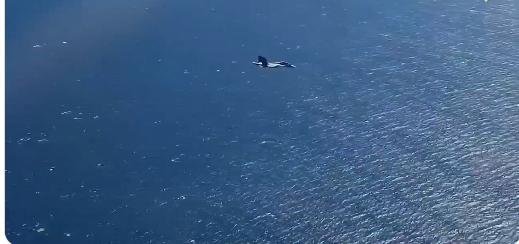America is testing drone warfare options against the Russians. Whenever you see anything in media that says Ukraine is doing this or that with drone, know it is the U.S. testing various warfare methods.
From The Right
- Breitbart: “Ukraine’s use of naval drones represents a new phase in the conflict, one where the smaller nation can leverage advanced technology to challenge a larger adversary. It’s a clear sign that with the right tools, David can still challenge Goliath on the high seas.”
From the Left
- New York Times: “Ukraine’s increasing reliance on drones, both in the air and at sea, reflects a broader shift towards asymmetric warfare. These attacks have not only disrupted Russian supply lines but have also forced Russia to divert resources to protect its naval assets, illustrating the disruptive potential of modern technology in traditional conflict zones.”
“We’ve got her in sight,” the drone operator reported, his voice even and composed, with a subtle undercurrent of enthusiasm. From where we stood on the sun-baked shore, the vessel appeared as a mere silhouette, bobbing lightly on the waves as it made its way toward the naval base. The air was thick with heat and tension, soldiers beside me squinting against the midday glare, beads of sweat tracing lines down their sunburned faces. One soldier, a technician from Ukraine’s military intelligence, moved forward, splashing into the shallow surf in his rubber boots. As the vessel drifted closer, he reached out with a careful hand, letting the machine glide gently into his grasp. His touch was almost tender, like a parent greeting a child, a silent gesture that seemed to echo the sentiment of a nation fighting against all odds.
Ukraine struck the Kransnodar region for the first time, knocking out Russian oil facilities at the port of Kavkaz on the Black Sea. The ferry sank but there is no damage or fire in the port area itself.
-Amir Tsarfati pic.twitter.com/tR3xc5VfN0
— CJC (@cj_chep) August 23, 2024
Up close, the drone didn’t look much like a weapon at all. It was small, almost unassuming, without the trappings of terror one might expect. No visible weaponry, no intimidating insignias, no obvious clues that it carried the potential to change the course of war. But this was the Magura—a seaborne specter, feared by the Russian navy and a pivotal player in Ukraine’s defiance against a larger foe. This unremarkable craft, with its quiet engine and modest frame, had disrupted Russian dominance in the Black Sea, outmaneuvering a historically formidable naval power with nothing more than innovation and determination.
Despite lacking a fleet of formidable warships, Ukraine has managed to use these drones to devastating effect. At just $200,000 apiece, they’ve become symbols of ingenuity over might, damaging or sinking around two dozen Russian vessels, including massive landing ships and missile carriers worth billions. The effectiveness of these drones has forced the Russian fleet to retreat, pulling back from Ukrainian shores, conceding space in what has become one of the largest naval confrontations since World War II. Standing face to face with the Magura, it’s difficult to reconcile its diminutive size with its vast impact.
Historically, Russia’s naval strength has been a source of national pride and strategic advantage, a tradition going back centuries to Peter the Great, who dreamt of maritime dominance. Today, those dreams are being dashed by a drone conceived not in a high-tech lab, but in a Kyiv garage. The sight of Russian ships pulling back, their once imposing presence now muted and withdrawn, marks a seismic shift in the narrative of this war. President Putin himself seems to have recognized this shift—first dismissing the commander of the Black Sea fleet, then the head of the entire navy, as if to exorcise the ghosts of these failures from the Kremlin’s halls.
🇺🇦 The Ukrainian Navy also bomb port facilities with its powerful drone unit, “Black 6”.
⚓ A unit of the Navy of the Armed Forces of Ukraine destroyed the enemy warehouse of ammunition and fuel and lubricants on the Kinburn Spit in the Black Sea.Together to Victory! pic.twitter.com/CCIe8nDxNk
— Kakka🎖️ (@kakkamax) August 24, 2024
“So, what do you think?” one of the engineers asked, a sly grin spreading across his face. “Fancy taking her for a spin?” The question hung in the air, a surprising offer from Ukraine’s notoriously secretive intelligence sector, a place where secrets are guarded like family heirlooms. Yet, there was an undeniable sense of pride in his voice, a desire to show the world what Ukraine has built—not just a weapon, but a symbol of resilience, a testament to the spirit of a nation that refuses to bow.
The urgency in showcasing this technology is palpable. Ukraine is under immense pressure not only to defend its borders but to demonstrate strength, to show the world—and themselves—that they can strike back, push back, and hold their ground. This defiance reached a new peak in August, when Ukrainian forces smashed through Russian defenses, reclaiming a thousand square kilometers in a matter of days. It was a bold move, breaking the bloody stalemate that had defined much of the conflict. “The enemy is trying to improve its negotiating position,” Putin said, recognizing that this was about more than just land; it was about leverage, power, and the future of this war.
Tactical Innovation: Ukraine has employed naval drones (unmanned surface vehicles or USVs) to target Russian ships and infrastructure in the Black Sea. These drones are typically small, fast, and difficult to detect, making them effective in asymmetrical warfare against a larger naval force.
In the waters of the Black Sea, Ukraine’s strategy has been one of relentless pressure, using these drones to not just strike fear but to force the Russians into a corner, proving that strength doesn’t always come from size. The balance of power at sea, once so heavily skewed in Russia’s favor, now tilts precariously, with every drone strike shifting the scales. It’s a game of chess, with each move more daring than the last, as Ukraine seeks to not just survive, but to redefine the rules of engagement.
Su-30SM multifunctional fighter jets of the Black Sea Fleet’s naval aviation destroyed the AFU’s unmanned boats in the Black Sea. https://t.co/BxZG0P9E3z pic.twitter.com/iCt8yuukL9
— Zlatti71 (@Zlatti_71) May 22, 2024
In the early days of the Russian invasion, few believed Ukraine could withstand the might of their neighbor’s forces. The Ukrainian navy, a shadow of its former Soviet self, seemed outmatched and outgunned. But the past years have taught a lesson in humility to the Russian fleet, showing that the old rules no longer apply. With each successful strike, Ukraine has rewritten the narrative, turning a fleet of modest, unmanned vessels into the unlikely heroes of a new kind of warfare.
Key Incidents: Ukrainian naval drones have been involved in several high-profile incidents:
- In October 2022, a Ukrainian drone attack damaged the Russian Black Sea Fleet’s flagship, the “Admiral Makarov.”
- In 2023, Ukraine expanded its drone attacks, targeting key logistical hubs and supply routes used by the Russian navy.
The Magura, born out of necessity, refined through adversity, stands as a testament to Ukraine’s innovative spirit. These drones have become more than tools of war; they are messages sent across the waves, each one a reminder that Ukraine is still here, still fighting, and still capable of striking back. As Zelensky and his generals plot their next moves, one thing is clear: in this war of attrition and resilience, Ukraine is not merely holding the line; it is pushing it forward, one drone at a time, into a future where David not only stands up to Goliath but changes the very nature of the battlefield itself.
More Information
- Strategic Importance: The Black Sea is a crucial area for both Ukraine and Russia. It provides Russia with access to Mediterranean waters and serves as a supply route for its southern military operations. For Ukraine, naval drones offer a cost-effective method to challenge Russian dominance in the region.
- International Support and Concerns: The effectiveness of Ukraine’s naval drones has been supported by Western technology and intelligence, but their use also raises concerns about escalation, particularly regarding the potential targeting of Russian civilian or economic infrastructure.
Major Points
- Ukrainian naval drones, like the Magura, have disrupted Russian dominance in the Black Sea, forcing the Russian fleet to retreat.
- Despite their small size and unassuming appearance, these drones have sunk or damaged around two dozen Russian vessels, showcasing Ukraine’s innovative approach to warfare.
- The success of the drones highlights a shift in the balance of power at sea, with Ukraine leveraging technology and strategy to challenge a historically superior naval force.
- The Ukrainian navy, once considered outmatched, has turned the tide using ingenuity and resilience, redefining the rules of engagement in modern warfare.
- Ukraine’s continued use of these drones symbolizes its defiance and determination to not just survive but to actively push back against Russian aggression.
Susan Guglielmo – Reprinted with permission of Whatfinger News


